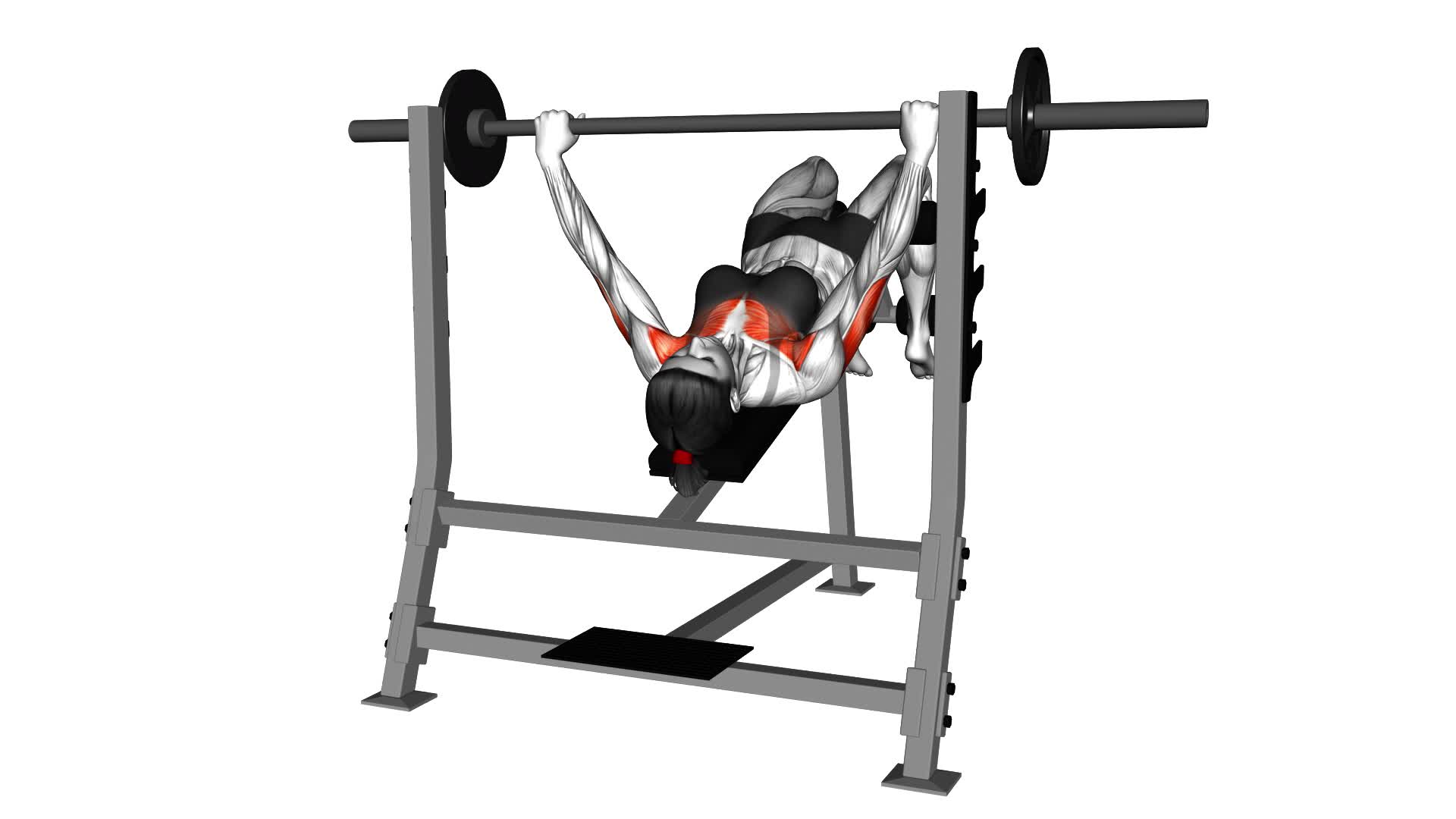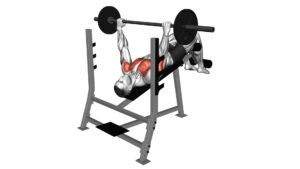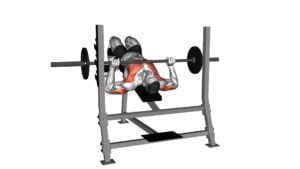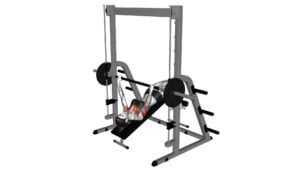Barbell Decline Bench Press (female) – Video Exercise Guide & Tips

Looking to strengthen your chest muscles? The barbell decline bench press is a great exercise for females.
Watch This Exercise Video
This video exercise guide and tips will show you the proper form and technique. Whether you're a beginner or advanced, there are variations and modifications for all fitness levels.
Avoid common mistakes and maximize your results with these helpful tips.
Get ready to pump up the intensity and prevent injury with this effective workout.
Key Takeaways
- Barbell Decline Bench Press for females builds strength and tones chest muscles
- The exercise targets lower chest muscles effectively and activates a greater number of muscle fibers in the chest
- Barbell Decline Bench Press leads to greater muscle growth and development in females
- It improves upper body strength by engaging shoulders and triceps
Benefits of the Barbell Decline Bench Press
One major benefit of the Barbell Decline Bench Press is that it helps you build strength and tone your chest muscles. This exercise specifically targets the lower chest muscles, which can be challenging to isolate with other exercises. By performing the Barbell Decline Bench Press, you activate a greater number of muscle fibers in your chest compared to other chest exercises. This increased muscle activation leads to greater muscle growth and development.
In addition to increased muscle activation, the Barbell Decline Bench Press also helps to improve your upper body strength. This exercise engages not only your chest muscles but also your shoulders and triceps. As you lower the barbell towards your chest and push it back up, these muscles are working together to support the movement. Over time, this repetitive action strengthens and develops these muscle groups, leading to enhanced upper body strength.
To maximize the benefits of the Barbell Decline Bench Press, it's important to maintain proper form and technique. Start with a weight that challenges you but allows you to perform the exercise with proper form. Focus on keeping your back flat against the bench, your feet firmly planted on the ground, and your elbows at a 45-degree angle. By following these guidelines, you can safely and effectively build strength and tone your chest muscles while improving your upper body strength.
Proper Form and Technique for Females
How can females ensure proper form and technique while performing the Barbell Decline Bench Press? Female strength training is essential for building upper body strength, and mastering the correct form is crucial to prevent injury and maximize results. Here is a step-by-step guide to help you achieve proper form and technique:
- Set up the decline bench at a comfortable angle, usually between 15 to 30 degrees.
- Lie down on the bench with your feet securely placed on the footrests, ensuring stability.
- Grip the barbell with your hands slightly wider than shoulder-width apart, palms facing forward.
- Lower the barbell slowly and under control towards your lower chest, keeping your elbows at a 45-degree angle.
- Pause for a moment when the barbell touches your chest, then press it back up to the starting position, fully extending your arms.
- Keep your core engaged and back flat throughout the movement.
- Exhale as you press the barbell up and inhale as you lower it down.
- Perform the exercise with a controlled tempo, avoiding excessive bouncing or arching of the back.
Variations and Modifications for Different Fitness Levels
To cater to different fitness levels, there are several variations and modifications that can be implemented for the Barbell Decline Bench Press exercise. If you're a beginner or have limited upper body strength, you can start with a lighter weight or use dumbbells instead of a barbell. This allows you to focus on proper form and technique before progressing to heavier weights.
Another option is to perform the exercise on an incline bench instead of a decline bench. This variation targets the upper chest and shoulders more, making it suitable for intermediate or advanced lifters looking to add variety to their workout.
Safety considerations should always be a priority when performing the Barbell Decline Bench Press. Make sure to use a spotter, especially when lifting heavier weights, to ensure your safety and prevent accidents. It's also important to maintain proper form throughout the exercise to avoid strain or injury. Keep your back flat against the bench, engage your core, and use a controlled motion when lowering and lifting the barbell.
By incorporating these progression options and considering safety precautions, you can customize the Barbell Decline Bench Press to suit your fitness level and goals.
Now, let's move on to the next section and discuss common mistakes to avoid during the exercise.
Common Mistakes to Avoid During the Exercise
Avoiding common mistakes during the Barbell Decline Bench Press exercise is crucial for maximizing results and preventing injury. To ensure proper technique, there are a few common mistakes to avoid.
Firstly, avoid arching your back excessively as this can put strain on your lower back and lead to injury. Keep your back flat against the bench throughout the entire movement.
Secondly, don't let your elbows flare out to the sides. This can cause unnecessary stress on your shoulders and increase the risk of injury. Instead, keep your elbows tucked in close to your body as you lower and lift the barbell.
Another common mistake is using too much weight. It's important to start with a manageable weight and gradually increase as you build strength and confidence. Using too much weight can compromise your form and increase the risk of injury.
Lastly, avoid bouncing the barbell off your chest. This not only reduces the effectiveness of the exercise but can also lead to chest muscle strains. Instead, lower the barbell in a controlled manner, pause briefly at the bottom, and then press it back up using your chest muscles.
Tips for Maximizing Results and Preventing Injury
To maximize your results and prevent injury during the Barbell Decline Bench Press exercise, focus on proper form and technique.
One important tip is to avoid overexertion by starting with a weight that's appropriate for your strength level. Gradually increase the weight as you become more comfortable and confident with the exercise.
It's also crucial to incorporate a proper warm-up before starting the exercise. This can include dynamic stretching, such as arm circles and leg swings, to increase blood flow to the muscles and prepare them for the workout.
Additionally, ensure that your grip on the barbell is secure and that your wrists are in a neutral position to prevent strain or injury. As you lower the barbell, keep your elbows tucked in and your back firmly pressed against the bench. This will help maintain stability and prevent excessive strain on your shoulder joints.
Remember to breathe consistently throughout the exercise, exhaling as you push the barbell up and inhaling as you lower it.
Frequently Asked Questions
How Many Sets and Reps Should I Do for the Barbell Decline Bench Press?
To determine the number of sets and reps for the barbell decline bench press, consider your fitness goals and current strength level. Generally, it's recommended to perform 3-4 sets of 8-12 reps for muscle growth and strength. However, you can adjust the sets and reps based on your preferences and capabilities.
The barbell decline bench press offers numerous benefits such as targeting the lower chest and engaging the triceps and shoulders. Additionally, there are variations of this exercise like the dumbbell decline bench press and machine decline press.
Can the Barbell Decline Bench Press Help Me Lose Weight?
Yes, the barbell decline bench press can help you lose weight. By incorporating this exercise into your routine, you'll be engaging multiple muscle groups, which can increase your overall calorie burn. The barbell decline bench press specifically targets your chest, shoulders, and triceps, helping to build lean muscle mass.
Additionally, this exercise can improve your upper body strength and enhance your overall athletic performance. Just make sure to maintain proper barbell decline bench press form to maximize the benefits.
Is It Safe for Pregnant Women to Perform the Barbell Decline Bench Press?
During pregnancy, it's important to take precautions when it comes to fitness. The barbell decline bench press may not be safe for pregnant women due to the increased risk of injury and strain on the abdominal muscles.
However, there are alternative exercises that can be performed to maintain fitness during pregnancy.
It's always best to consult with your healthcare provider or a certified prenatal fitness specialist for personalized guidance and recommendations.
Can the Barbell Decline Bench Press Help Improve My Posture?
Improving your posture is an important goal, and the barbell decline bench press can help you achieve it.
This exercise targets your chest, shoulders, and triceps, which can strengthen the muscles that support good posture.
By performing the barbell decline bench press correctly and consistently, you can reap the benefits of improved posture, such as reduced risk of back pain and increased confidence.
Remember to start with lighter weights and focus on maintaining proper form throughout the exercise.
Should I Use a Spotter When Performing the Barbell Decline Bench Press?
When performing the barbell decline bench press, it's highly recommended that you use a spotter. This exercise can be challenging, and having a spotter ensures that you have assistance if you need it. A spotter can help you maintain proper form and prevent any potential injuries.
However, if you don't have access to a spotter, there are alternative exercises you can do to target the same muscle groups, such as the dumbbell decline bench press or the machine decline press.
Conclusion
In conclusion, the barbell decline bench press is an effective exercise for females looking to strengthen their chest, shoulders, and triceps.
By maintaining proper form and technique, individuals can maximize their results and prevent injury.
Modifications and variations can be made to accommodate different fitness levels.
It's important to avoid common mistakes and follow the tips provided to ensure a safe and effective workout.
Incorporating this exercise into your fitness routine can help you achieve your strength and fitness goals.

Author
Years ago, the spark of my life’s passion ignited in my mind the moment I stepped into the local gym for the first time. The inaugural bead of perspiration, the initial endeavor, the very first surge of endorphins, and a sense of pride that washed over me post-workout marked the beginning of my deep-seated interest in strength sports, fitness, and sports nutrition. This very curiosity blossomed rapidly into a profound fascination, propelling me to earn a Master’s degree in Physical Education from the Academy of Physical Education in Krakow, followed by a Sports Manager diploma from the Jagiellonian University. My journey of growth led me to gain more specialized qualifications, such as being a certified personal trainer with a focus on sports dietetics, a lifeguard, and an instructor for wellness and corrective gymnastics. Theoretical knowledge paired seamlessly with practical experience, reinforcing my belief that the transformation of individuals under my guidance was also a reflection of my personal growth. This belief holds true even today. Each day, I strive to push the boundaries and explore new realms. These realms gently elevate me to greater heights. The unique combination of passion for my field and the continuous quest for growth fuels my drive to break new ground.







